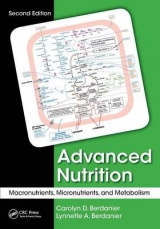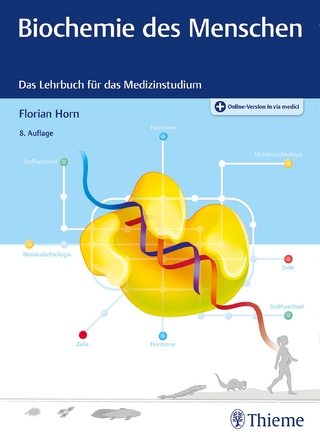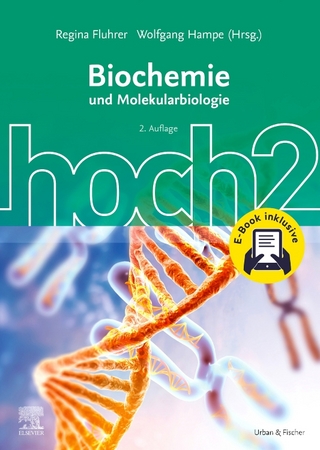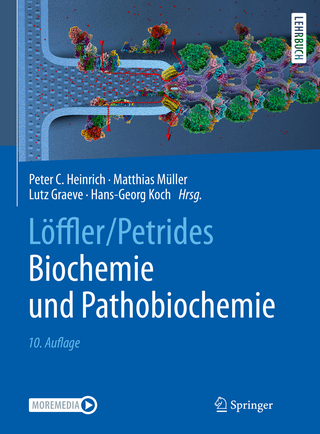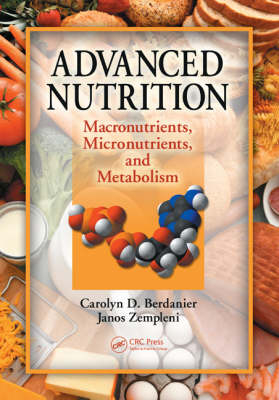
Advanced Nutrition
Crc Press Inc (Verlag)
978-1-4200-5552-8 (ISBN)
- Titel erscheint in neuer Auflage
- Artikel merken
Nutrition science has evolved considerably in the past decade with new concepts and discoveries. In response, advanced nutrition courses now encompass material on macronutrients and micronutrients, subjects that have traditionally been studied separately. The brand new edition of Advanced Nutrition: Macronutrients, Micronutrients, and Metabolism is a completely updated and expanded revision of two prior works, Advanced Nutrition Micronutrients and Advanced Nutrition Macronutrients, Second Edition, combined into one book for the first time. As in the original editions, this book has been written for those with a background in biochemistry and physiology who may or may not have a background in nutrition and dietetics. The first half of the text introduces integral concepts in nutrition science, such as energy, regulation of food intake, nutritional biochemistry, cell cycle, nutrigenomics, and epigenetics.
The second portion of the book focuses on specific micronutrients and macronutrients with respect to their roles in metabolism. For ease of understanding, each chapter follows a specific format detailing each nutrient’s definition, absorption, use, and excretion. Chapters include discussions on protein, carbohydrates, lipids, vitamins, and minerals. Woven throughout the text are topics of clinical interest such as obesity, diabetes, lipemia, renal disease, and other conditions influenced by nutrition.
New in this Edition:
Regulation of food intake and feeding behavior
Daily recommended nutrient intakes
Metabolism
Toxicology
Nutrigenomics, epigenetics, and gene expression
Cell cycle and life span nutrition
The book presents a wealth of illustrations, diagrams, and tables that make complex concepts easy to grasp. It also provides references and a glossary of terms. The accompanying CD-ROM includes PowerPoint® slides of additional material. These features make it a resource that will spend more time on the desktop than on the bookshelf.
University of Georgia, Athens, USA University of Nebraska, Lincoln, USA
Energy
Definition
Energy Need
Energy Retained
Energetic Efficiency
Utilizable Energy
Thermogenesis
Abnormal Energy States
Starvation and Undernutrition
Protein-Energy Malnutrition
Trauma and Energy Needs
Obesity
Body Composition
Set Point Theory in Body Weight Regulation
Morbidity of Severely Obese People
Treatment of Obesity
Drugs for the Treatment of Obesity
References
Regulation of Food Intake
Psychological Aspects of Food Intake
Physiological Aspects of Food Intake
Sensory Perception of Food
Appearance
Texture
Smell (Olfaction) and Gustation (Taste)
Neuronal Signals for Hunger and Satiety
Anorexia Nervosa and Bulimia
Abnormal Appetite: Pica
References
Nutritional Biochemistry
Glycolysis
Hexose Monophosphate Shunt
Interconversion of Dietary Sugars
Fructose
Contents
Galactose
Mannose
Glycogenesis and Glycogenolysis
Gluconeogenesis
Cori and Alanine Cycles
Oxidative Phosphoylation
Mitochondrial Structure and Function
Respiration and the Citric Acid Cycle
Respiratory Chain
ATP Synthesis
Uncoupling Proteins
Metabolic Control: Oxidative Phosphorylation
Oxidative Phosphorylation
Fatty Acid Synthesis
Fatty Acid Elongation
Fatty Acid Desaturation
Fatty Acid Esterification
Fatty Acid Oxidation
Cholesterol Synthesis
Amino Acid Catabolism
Amino Acid Derivatives
Creatine Phosphate
Choline
Polyamines
References
Cell Cycle, Life Cycle
Cell Structure and Function
Receptors
Signal Systems
Cell Differentiation
Apoptosis
Life Cycle
Growth and Development
Aging
References
Nutrigenomics and Epigenetics
Gene Expression
Gene Structure
Mutation or Polymorphisms
Synthesis of Purines and Pyrimidines
Transcription
Epigenetic Control of Chromatin Structure and Function
Genetic Diseases of Interest to Nutrition
References
Protein
Amino Acids
Chemistry
Stereochemistry
Acid-Based Properties
Reactions
Amino Acid Derivatives
Creatine phosphate
Choline
Polyamines
Peptides
Protein Structure
Protein Denaturation
Classification of Proteins
Classification by Solubility and Prosthetic Groups
Glycoproteins
Lipoproteins
Nucleoproteins
Other Conjugated Proteins
Classification by Function
Classification by Nutritive Value
Protein Analysis
Biological Value of Dietary Protein (BV)
Protein Use
Digestion
Absorption
Metabolism
Hormones: Regulators of Protein Metabolism
Protein Turnover
Protein Degradation
Functions of Proteins
Proteins as Enzymes
Proteins as Carriers and Receptors
Proteins as Regulators of Water Balance
Proteins as Biological Buffers
Proteins as Structural Elements and Structural Units
Proteins as Lubricants
Proteins in the Immune System
Proteins as Signaling Molecules
Protein Intake Recommendations
Age
Environmental Temperature
Previous Diet
Physical Activity
Protein Deficiency
Kwashiorkor
Marasmus
Protein and Amino Acid Interactions with Other Nutrients
Vegetarian Diets
Renal Disease
Integration of the Metabolic Features of Protein Nutrition
References
Carbohydrates
Classification
Structure and Nomenclature
Monosaccharides
Stereoisomeric Forms
Anomeric Forms
Oligosaccharides
Disaccharides
Polysaccharides
Storage Polysaccharides
Structural Polysaccharides
Mucopolysaccharides
Sources of Carbohydrate
Digestion and Absorption
Metabolism
Glucose Homeostasis
Abnormalities in the Regulation of Glucose Homeostasis: Diabetes Mellitus
Prevalence of Diabetes
The Glucose Tolerance Test
Definition of Different Types of Diabetes Based on Management
Genetics and Diabetes
Type Diabetes (Autoimmune Diabetes)
Pancreatic Islet ß Cell Failure
Autoimmune Disease
Diabetes Secondary to Viral Infections
Insulin Release
Maturity-Onset Diabetes of the Young (MODY)
Genetic Errors in Insulin Structure
Mitochondrial Diabetes
Peripheral Insulin Resistance
Animal Models for Humans with Type 2 Diabetes
Population Surveys Relating Diet to Diabetes
Prospective Studies Linking Food Intake to a Reduction in Type 2 Diabetes
Dietary Intervention in Diabetes
Other Intervention Studies
Overall Management of Both Type 1 and Type 2 Diabetes
Other Health Concerns in Carbohydrate Nutrition
Fiber
Ethanol
Carbohydrate Needs
References
Lipids
Classification
Structure and Nomenclature
Simple Lipids
Fatty Acids
Triacyglycerols (Fats or Triglycerides)
Sources of Lipids
Digestion and Absorption
Transport
Endogenous Lipid Transport
Genetic Basis for Lipoproteinemia
Nutrient–Gene Interactions in Lipid Transport
Function
Essential Fatty Acids
Eicosanoid Synthesis
Fatty Acid Autooxidation
Nutrition, Inflammation, and Chronic Disease
The Injury Cycle
Relationship of Inflammation to Chronic Disease
Aging and Free Radicals
Marine Oils and Health Concerns
Lipids and Membrane Function
Membrane Phospholipid Composition
Disease Effects on Membrane Lipids
Hormonal Effects on Membrane Lipids
Age Effects on Membrane Lipids
Membrane Function
Cancer and Dietary Fat
Other Diseases
References
Fat-Soluble Vitamins
Vitamin A
Structure and Nomenclature
Chemical Properties
Biopotency
Sources
Metabolism of Vitamin A
Functions
Hypervitaminosis A
Vitamin Degradation and Excretion
Need
Vitamin D
Structure and Nomenclature
Physical/Chemical Properties
Biopotency
Methods of Assay
International Units (IU)
Metabolism
Absorption
Transport
Metabolism
Function
Regulation of Serum Calcium Levels
Vitamin D Deficiency
Hypervitaminosis D
Need
Vitamin E
Structure and Nomenclature
International Units and Methods of Analysis
Chemical and Physical Properties
Sources
Metabolism
Absorption and Transport
Intracellular Transport and Storage
Catabolism and Excretion
Function
Hypervitaminosis E
Deficiency
Need
Vitamin K
Structure and Nomenclature
Biopotency
Chemical and Physical Properties
Chemical Assays
Bioassays
Biosynthesis
Antagonists, Antivitamins
Absorption
Metabolism and Function
Deficiency
Sources
Need
References
Water-Soluble Vitamins
Ascorbic Acid
Structure, Physical, and Chemical Properties
Sources
Absorption and Metabolism
Distribution
Function
Deficiency
Toxicity
Need
Thiamin
Structure
Thiamin Antagonists
Assays for Thiamin
Sources
Absorption and Metabolism
Biological Function
Deficiency
Needs
Toxicity
Riboflavin
Structure, Chemical, and Physical Properties
Sources
Assay
Absorption and Metabolism
Function
Deficiency
Needs
Niacin, Nicotinic Acid
Structure, Physical, and Chemical Properties
Sources
Absorption and Metabolism
Function
Deficiency
Need
Pyridoxine
Structure, Physical, and Chemical Properties
Sources
Absorption and Metabolism
Function
Deficiency
Need
Pantothenic Acid
Structure, Chemical, and Physical Properties
Sources
Absorption and Metabolism
Function
Deficiency Symptoms
Need
Biotin
Structure, Physical, and Chemical Properties
Sources
Absorption and Metabolism
Function
Deficiency
Need
Folic Acid
Structure, Chemical, and Physical Properties
Sources
Absorption and Metabolism
Function
Deficiency
Need
Vitamin B12
Structure, Physical, and Chemical Properties
Absorption and Metabolism
Function
Deficiency
Need
Carnitine
Structure, Physical, and Chemical Properties
Sources
Absorption and Metabolism
Function
Deficiency
Choline
Structure, Physical, and Chemical Properties
Sources
Absorption and Metabolism
Function
Deficiency
Need
Inositol
Structure, Physical, and Chemical Properties
Absorption and Metabolism
Function
Deficiency
Need
Other Compounds That May or May Not Be Vitamins
Pyrroloquinoline Quinone
Ubiquinone
Orotic Acid
Para Amino Benzoic Acid (PABA)
Lipoic Acid
Bioflavinoids
Pseudovitamins
References
Macrominerals
Sodium
Regulation of Serum Sodium
Function
Potassium
Chloride
Function
Calcium
Sources
Food Mixtures
Bioavailability
Apparent Absorption
Physiological Status
Mechanisms of Absorption
Calcium Transport, Blood Calcium Regulation
Function
Cell Signaling
Calcium and Cell Death
Muscle Contraction
Calcium Deficiency
Need
Phosphorus
Function
Magnesium
Absorption, Metabolism, Excretion
Function
Deficiency
Need
References
Trace Minerals
Essential Microminerals
Trace Mineral Toxicity
Antagonisms and Interactions among Trace Minerals
Iron
Absorption, Excretion, Metabolism
Iron-Containing Materials in the Body
Iron Needs
Iron Deficiency (Anemia)
Pharmacological Treatment of Iron Deficiency
Toxicology
Zinc
Absorption, Metabolism, Excretion
Function
Storage
Zinc Interactions
Deficiency
Status
Copper
Absorption, Metabolism, Excretion
Function
Deficiency
Abnormal Copper Status
Selenium
Absorption, Excretion, Metabolism
Function
Selenium–Mineral Interactions
Deficiency
Toxicity
Iodine (Iodide)
Absorption, Metabolism, Excretion
Deficiency
Need
Molybdenum
Absorption and Excretion Function
Food Sources and Recommended Intake
Manganese
Absorption and Excretion Function
Food Sources, Recommended Intake
Toxicity
Cobalt
Toxicity, Mineral Interactions
Other Minerals
References
Glossary
Index
| Zusatzinfo | 13 equations; 20 Halftones, black and white; 115 Tables, black and white; 196 Illustrations, black and white |
|---|---|
| Verlagsort | Bosa Roca |
| Sprache | englisch |
| Maße | 178 x 254 mm |
| Gewicht | 975 g |
| Themenwelt | Medizin / Pharmazie ► Gesundheitsfachberufe ► Diätassistenz / Ernährungsberatung |
| Studium ► 1. Studienabschnitt (Vorklinik) ► Biochemie / Molekularbiologie | |
| Naturwissenschaften ► Biologie | |
| ISBN-10 | 1-4200-5552-6 / 1420055526 |
| ISBN-13 | 978-1-4200-5552-8 / 9781420055528 |
| Zustand | Neuware |
| Haben Sie eine Frage zum Produkt? |
aus dem Bereich
